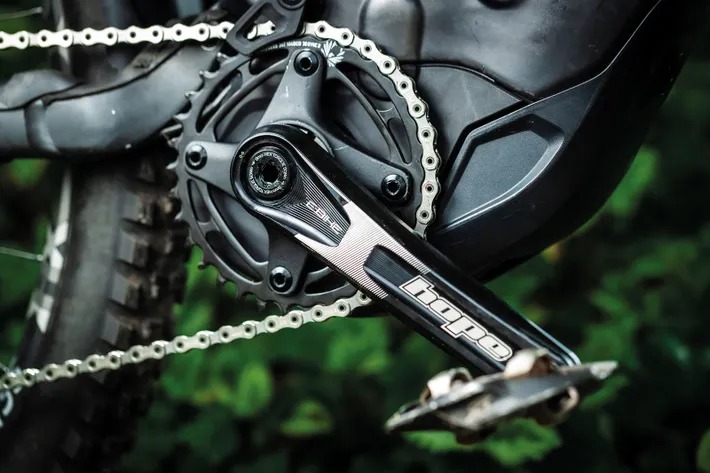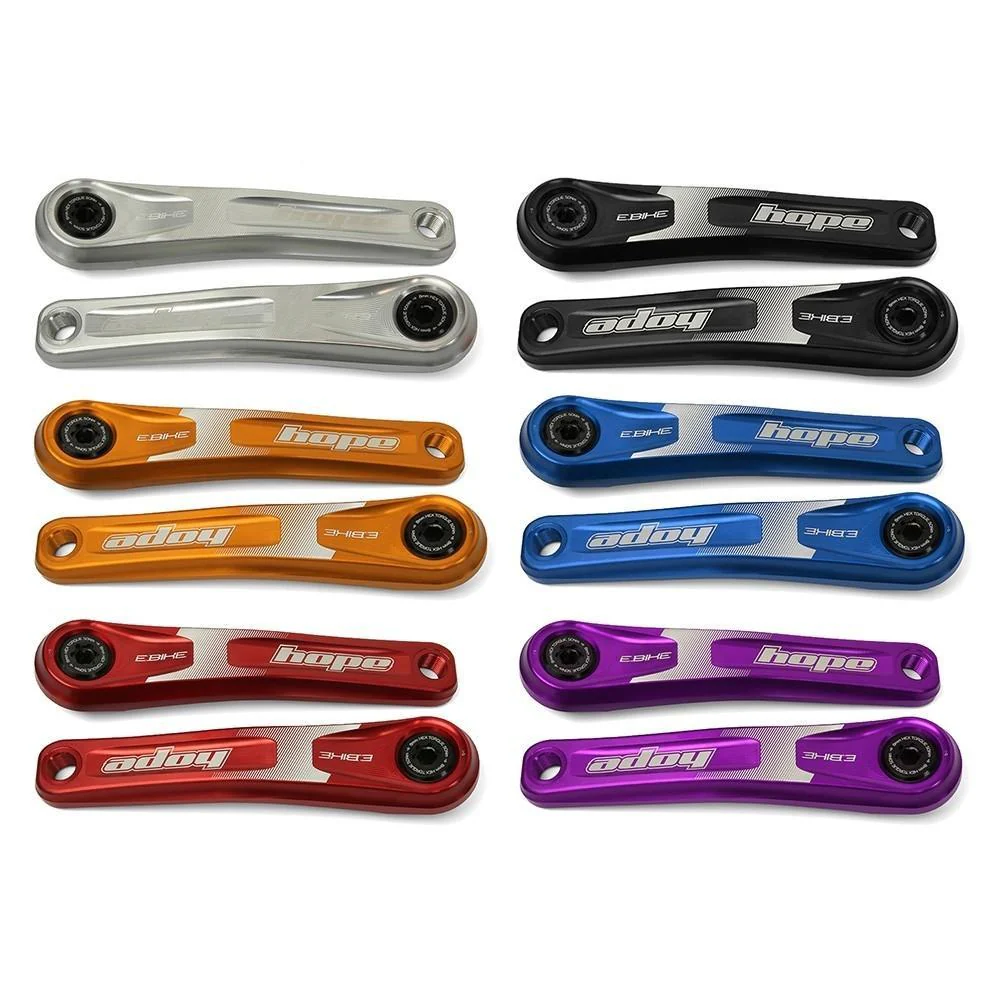If you’re new to e-bikes, you might have heard terms like crankset, chainrings, and cranks, but what do they mean? More importantly, how do they affect your riding experience? Understanding your e-bike crankset is crucial for optimizing performance, comfort, and efficiency.
Your crankset is a key part of the e-bike drivetrain, and choosing the right one can make a noticeable difference in power transfer, pedal efficiency, and overall riding experience. Whether you’re looking to upgrade or simply want to understand how your bike works, this guide covers everything you need to know. By the end, you’ll have a solid grasp of e-bike chainrings, cranks, and how they impact performance.
Table of Contents
Table of Contents
Understanding the E-Bike Crankset

Your e-bike crankset is one of the most important components of your bike. It’s responsible for transferring power from your legs to the drivetrain, which ultimately moves the bike forward. The crankset consists of two main parts:
- E-Bike Chainrings: The toothed rings that hold the chain and rotate as you pedal.
- E-Bike Cranks: The arms that connect the pedals to the bottom bracket, allowing you to turn the chainrings.
Unlike traditional bicycles, e-bikes have motor-assisted pedaling, which means the crankset needs to work efficiently with the motor to deliver smooth power transfer. Choosing the right crankset can impact everything from torque, cadence, battery efficiency, and comfort.
One of the key differences in e-bike cranksets is that they must withstand additional stress due to the increased power output of electric motors. As a result, they are often reinforced with stronger materials and are designed for optimal torque distribution.
E-Bike Chainrings: What You Need to Know
The chainring is a critical part of your e-bike drivetrain. It affects your speed, torque, and overall riding experience. Here’s what you need to know:
Single vs. Double Chainrings
- Single Chainring (1x setup): Common in e-bikes due to simplicity and reliability. Requires less maintenance and is compatible with most pedal assist systems.
- Double Chainring (2x setup): Offers more gear range but adds complexity and weight. Typically found on high-performance e-bikes.
While a single chainring setup is preferred for ease of use and durability, a double chainring setup provides better control over gear ratios, making it ideal for advanced riders who tackle varied terrain.
How Chainring Size Affects Performance
- Larger Chainrings (44T-52T): Provide higher top speeds but require more effort to pedal.
- Smaller Chainrings (32T-42T): Offer better acceleration and climbing power, making them ideal for hilly terrain.
The right chainring size depends on your riding style and terrain. If you commute daily on flat roads, a larger chainring might be beneficial for a higher cruising speed. If you frequently ride on trails or hills, a smaller chainring will make climbing easier and more efficient.
E-Bike Cranks: Choosing the Right Ones
The cranks are the arms that connect your pedals to the bottom bracket. Their length and material can impact efficiency, pedaling comfort, and even knee health.

E-Bike Crank Arm Length Guide
- Shorter Cranks (160-170mm): Ideal for smaller riders and e-bikes with high pedal assist.
- Standard Cranks (170-175mm): Suitable for most riders and terrain types.
- Longer Cranks (175mm+): Provide more leverage but require more effort to pedal.
Shorter crank arms can improve cadence and comfort, while longer crank arms provide more torque and power output. Choosing the correct length ensures a balance between efficiency and knee strain.
Crankset Material: Aluminum, Carbon, or Steel?
- Aluminum: Lightweight, affordable, and durable—perfect for most riders.
- Carbon Fiber: Extremely light and stiff but expensive.
- Steel: Heavy but highly durable, great for rugged terrain and cargo e-bikes.
For casual commuters, aluminum is the best choice. Performance riders may prefer carbon fiber for weight savings, while off-road and heavy-duty riders should consider steel for extra durability.
How to Choose an E-Bike Crankset
When selecting an e-bike crankset, consider the following factors:
1. Bottom Bracket Compatibility
Not all cranksets fit all e-bikes. Ensure your crankset matches your bottom bracket type to avoid compatibility issues.
2. Drivetrain Components
Your crankset should work seamlessly with your bike’s gears, chain, and derailleur. A mismatched crankset can cause poor shifting performance and power loss.
3. Power Transfer and Efficiency
A high-quality crankset enhances e-bike pedal efficiency by reducing energy loss, leading to smoother rides and longer battery life.
4. Torque Sensor & Cranksets
Some e-bikes have a torque sensor that adjusts motor assistance based on pedal force. The right crankset ensures accurate sensor readings for optimal performance.
5. Lightweight Components
If you want better acceleration and efficiency, opt for lightweight e-bike components, including a lighter crankset.
Upgrading Your E-Bike Crankset
Thinking about upgrading? Here’s what you need to know:
When to Upgrade
- If your crankset is worn out or damaged.
- If you want to improve performance with a better material or design.
- If you’re experiencing pedal inefficiency or discomfort.
Benefits of Upgrading
- Better Power Transfer: A quality crankset reduces energy loss, making rides smoother.
- Increased Comfort: The right e-bike crank arm length enhances pedaling efficiency.
- Improved Performance: A lighter, stronger crankset can enhance acceleration and climbing ability.
Best E-Bike Crankset for Your Needs
- For Commuters: Lightweight aluminum cranksets with a single chainring.
- For Off-Road Riders: Durable steel cranksets with a wide gear range.
- For Speed Enthusiasts: Carbon fiber cranksets with large chainrings.
Common Mistakes & FAQs
Common Mistakes to Avoid
- Choosing a crankset that doesn’t match your bottom bracket.
- Selecting the wrong chainring size for your riding style.
- Ignoring crank arm length, leading to discomfort or inefficiency.
Conclusion
Your e-bike crankset plays a crucial role in performance, comfort, and efficiency. Choosing the right one ensures a smoother, more enjoyable ride. Need help picking the best e-bike crankset? Drop a comment below or explore more e-bike drivetrain components to optimize your ride!
FAQ
Q: E-Bike Pedal Replacement and Upgrading for Comfort & Performance
A: E-Bike Pedal Replacement might seem like a minor change, but it can have a significant impact on your riding experience.
Q: How often should I replace my crankset?
A: With regular use, an e-bike crankset can last 5,000-10,000 miles. Replace it if you notice excessive wear or reduced efficiency.








